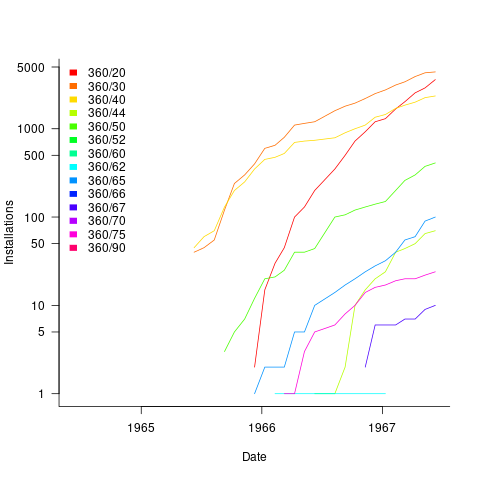Census of general purpose computers installed in the 1960s
In the 1960s a small number of computer manufacturers sold a relatively small number of general purpose computers (IBM dominated the market). Between 1962 and 1974 the magazine Computers and Automation published a monthly census listing the total number of installed, and unfilled orders for, general purpose computers. A pdf of all the scanned census data is available on Bitsavers.
Over the last 10-years, I have made sporadic attempts to convert the data in this pdf to csv form. The available tools do a passable job of generating text, but the layout of the converted text is often very different from the visible layout presented by a pdf viewer. This difference is caused by the pdf2text tools outputting characters in the order in which they occur within the pdf. For example, if a pdf viewer shows the following text, with numbers showing the relative order of characters within the pdf file:
1 2 6
3 7
4 5 8 |
the output from pdf2text might be one of the four possibilities:
1 2 1 2 1 1
3 3 2 2
4 5 4 3 3
6 5 4 5 4
7 6 6 5
8 7 7 6
8 8 7
8 |
One cause of the difference is the algorithm pdf2text uses to decide whether characters occur on the same line, i.e., do they have the same vertical position on the same page, measured in points ( inch, or ≈ 0.353 mm)?
inch, or ≈ 0.353 mm)?
When a pdf is created by an application, characters on the same visual line usually have the same vertical position, and the extracted output follows a regular pattern. It’s just a matter of moving characters to the appropriate columns (editor macros to the rescue). Missing table entries complicate the process.
The computer census data comes from scanned magazines, and the vertical positions of characters on the same visual line are every so slightly different. This vertical variation effectively causes pdf2text to output the discrete character sequences on a variety of different lines.
A more sophisticated line assignment algorithm is needed. For instance, given the x/y position of each discrete character sequence, a fuzzy matching algorithm could assign the most likely row and column to each sequence.
The mupdf tool has an option to generate html, and this html contains the page/row/column values for each discrete character sequence, and it is possible to use this information to form reasonably laid out text. Unfortunately, the text on the scanned pages is not crisply sharp and mupdf produces o instead of 0, and l not 1, on a regular basis; too often for me to be interested in manually correctly the output.
Tesseract is the ocr tool of choice for many, and it supports the output of bounding box information. Unfortunately, running this software regularly causes my Linux based desktop to reboot.
I recently learned about Amazon’s Textract service, and tried it out. The results were impressive. Textract doesn’t just map characters to their position on the visible page, it is capable of joining multiple rows within a column and will insert empty strings if a column/row does not contain any characters. For instance, in the following image of the top of a page:

the column names are converted to "NAME OF MANUFACTURER","NAME OF COMPUTER", etc., and the empty first column/row are mapped to "".
The conversion is not quiet 100% accurate, but then the input is not 100% accurate; a few black smudges are treated as a single-quote or decimal point, and comma is sometimes treated as a fullstop. There were around 20 such mistakes in 11,000+ rows of numbers/names. There were six instances where two lines were merged into a single row, when the lines should have each been a separate row.
Having an essentially accurate conversion to csv available, does not remove the need for data cleaning. The image above contains two examples of entries that need to be corrected: the first column specifies that it is a continuation of a column on the previous page (over 12 different abbreviated forms of continued are used) Honeywell (cont'd) -> Honeywell, and other pages use a slightly different name for a particular computer DATA-matic 1000 -> Datamatic 1000. There are 350+ cleaning edits in my awk script that catch most issues (code+data).
How useful is this data?
Early computer census data in csv form is very rare, and now lots of it is available. My immediate use is completing a long-standing dataset conversion.
Obtaining the level of detail in this census, on a monthly basis, requires some degree of cooperation from the manufacturer. June 1967 appears to be the last time that IBM supplied detailed information, and later IBM census entries are listed as round estimates (and only for a few models).
The plot below shows the growth in the number of IBM 360 installations, for various models (unfilled orders date back to May 1964; code+data):

Recent Comments